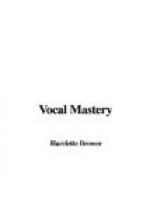“Thus the singer entices the voice to come forward and out, never treating it roughly or harshly, never forcing or straining it. Take pleasure in every tone you make; with patience and pleasure much is accomplished. I could not give you a more useful tip than this.”
“Will you tell me how you learn a song?” she was asked.
“I first read over the text and get a good idea of its meaning. When I begin to study the song, I never separate the music from the words, but learn both together. I play the piano of course, and thus can get a good idea of the accompaniment, and of the whole ensemble.
“I feel so strongly that real art, the highest art, is for those who truly understand it and its mission. A dream of mine is one day to found a school of true art. Everything in this school shall be on a high plane of thought. The instructors shall be gifted themselves and have only lofty ideals. And it will be such a happiness to watch the development of talent which may blossom into genius through having the right nurture. I shall watch this work from a distance, for I might be too anxious if I allowed myself to be in the midst of the work. But this is my dream, and I hope it will one day come true.”
XV
=MARIA BARRIENTOS=
BE YOUR OWN CRITIC
It is often remarked that the world has grown far away from coloratura singing; that what we want to-day is the singing actor, the dramatic singer, who can portray passion—tear it to tatters if need be—but at least throw into voice gesture and action all the conflicting emotions which arise when depicting a modern dramatic character. It is said, with much truth, composers do not write coloratura parts in these days, since audiences do not care to listen to singers who stand in the middle of the stage, merely to sing beautiful arias and tonal embroideries. Therefore there are very few coloratura singers at present, since their opportunities are so limited.
To the last objection it can be answered that audiences do still flock to hear a great coloratura artist, for they know they will hear pure, beautiful melodies when they listen to the old Italian operas. And melody proves to be a magnet every time; it always touches the heart.
Again, the coloratura singer is not obliged to stand in the middle of the stage, while she warbles beautiful tones, with seemingly little regard for the role she is enacting. The coloratura singer, who is an artist, can act as well as sing. Tetrazzini, as she moves about the room, greeting her guests, as she does in Traviata or Lucia, can at the same time keep right on with her florid song, proving she can think of both arts at once.
It is quite true there are not many coloratura singers of the first rank to-day. When you have mentioned Galli-Curci, Tetrazzini, Barrientos, and Frieda Hempel—the last is both lyric and coloratura—you have named all the great ones who are known to us here in America. There are a couple of younger artists, Garrison and Macbeth, who are rapidly gaining the experience which will one day place them in the charmed circle.




